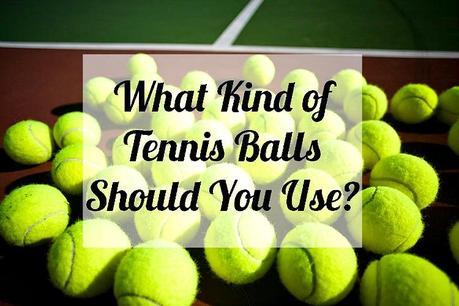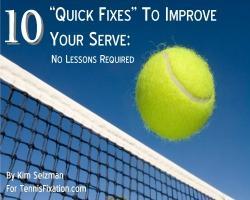Podcast: Play in new window | Download
Do you know the difference between extra duty and regular duty tennis balls? Pressurized and pressureless balls? In this episode of Tennis Quick Tips, you’ll learn all about tennis balls and you’ll know exactly which ones to use next time you hit the courts. You can listen to this episode by clicking on the media player above or by listening in with your favorite podcast app. You can also subscribe in iTunes by clicking on this link: tennisfixation.com/itunes.

SHOW NOTES:
Today, we’re going to talk about tennis balls. Did you realize there are different kinds of tennis balls? If not, you may be using the wrong ones. I was thinking about this because I got a questions from Mary, a good friend and a longtime Tennis Fixation supporter. As you know, I’m always asking you to submit your tennis questions to me and Mary sent one in that I thought was definitely worth answering with its own podcast episode. Mary says,
Got a complaint from one of the captain’s in the A Tuesday League that I coordinate. She had to play with “clay court” balls on a hard court and said her arm hurt so bad the next day that she had to go to the doctor. She wants me to address this with all the captains but I’m not real sure what to say. What’s the difference between tennis balls and can using “the wrong balls” really cause someone to hurt their arm?
Now, if you’re like me, you’re looking for only one kind of tennis balls – the cheap ones! I buy balls by the case at Costco so I always have a can on hand. And, if I happen to be in Wal-Mart, I’ll buy balls there too as they are often priced at less than $2 a can. I guess whoever is setting the prices at Wal-Mart is not a big tennis player and doesn’t realize they could get more than this.
But the fact is, there’s more to a tennis ball than it’s price. Without getting too technical (or boring), here’s the anatomy of a tennis ball – a rubber ball wrapped in a fuzzy fabric covering with either a solid rubber core or a hollow core filled with gas. When the core is solid, the ball is called “pressureless.” When the core is hollow, it is filled with pressurized air or nitrogen so the balls are called “pressurized.”
First, let’s consider that felt covering on the outside of the ball. If you hadn’t noticed, tennis balls come with two types of felt coverings – regular-duty and extra-duty. I used to not pay too much attention to this, just buying whatever was cheap or handy. And, consequently, I would have a wide variety of balls around; some regular-duty, some extra-duty.
Does that matter? Well, yes actually, it does. “Regular-duty” or “soft court” balls are designed for use on clay courts. As you might guess, tennis balls travel slower on clay courts than they do on hard courts or on grass. The clay absorbs the impact of the ball more readily than a hard court. Regular-duty balls therefore have a thinner and less fuzzy felt covering so that the balls will pick up less clay when used on those courts.
“Extra-duty” or “hard court” balls are for use on hard and grass courts. Their felt covering is thicker and they have more fuzz on them, allowing them to be used longer on hard courts. But you can imagine, this extra fuzzy covering on an extra-duty ball would become more caked with clay than would the less-fuzzy covering on a regular-duty ball. So you definitely want to avoid using an extra-duty ball on a clay court.
So, if you play on clay a lot, you should be using regular-duty balls as they should perform better and last a little longer. And if you play on hard courts or grass a lot, the extra-duty balls would be preferable not only because they will have a longer life, but that extra fuzz may help a tiny bit with increasing the spin you can put on the ball.
You can easily tell which kind of ball you’re playing with in two ways – first, look at the can! It’s written right on there. But if you’re somehow playing with balls that are not in the can, because maybe your opponent took them out of the can already and you don’t want to be rude or weird and ask to look at the can, just look at the brand name printed on the ball. Regular-duty balls will have the brand name printed in red, like red clay, while extra-duty balls will have the brand name printed in black. Useful trivia to know, right?
Okay, so what the heck is the difference between pressurized and pressureless tennis balls? And why should I care?
Pressurized balls are the ones you usually find in a single can of three – probably the ones you buy most of the time. Their benefits?
First, they have more bounce. Pressurized balls feel more “lively” when they first come out of the can. The can itself is vacuum sealed to prevent the pressurized gas inside the balls from leaking.
Second, they have more spin response. Because they’re lighter, you can generate more spin with these balls.
Finally, they allow you to hit with more speed. Since pressurized balls have less mass than pressureless balls, pressurized balls travel faster.
But the benefits of pressurized balls are, like a good haircut, very short-lived. Within two to four weeks (or less) of opening the can, these balls will become pretty much unplayable. As the pressurized gas inside the balls escapes, these balls lose their bounce and feel “dead” or “wooden.” That’s why you probably open a new can of balls every time you play a match that counts for something and why your league probably requires the home team to always provide new balls.
Pressureless balls, on the other hand, feel a little “dead” right from the start. But, over time, as the fuzzy fabric cover on the ball wears away and the rubber inside softens, these balls actually become more bouncy. While that sounds good, the fact that these balls are heavier means that they strike your racquet with more force. And they require your arm and the rest of your body to use more force in hitting them. The result can be an increase in injury. And while the balls may become bouncier, their spin response decreases over time. A definite negative in these days when so many people, even me, are trying to generate spin on their serves and ground strokes. So where will you see pressureless balls in use? They’re often used in lessons and in ball machines because of their longer life.
Okay, let’s talk about one final kind of ball that many of you have probably seen but may have never used. These are the red, orange and green dot balls that are now being used with junior players and even with some adult beginners who are just learning the game. While these balls are obviously not something you’re going to use in match play, junior players are using them in some of their matches. While these balls may look like standard tennis balls, sort of, they behave much differently. The red balls, for example, has only 25% of the pressure of a standard ball. So it bounces a lot less and moves a lot slower. The orange ball has 50% of the pressure and the green dot ball has 75%. This obviously allows players using these balls to keep them much more under control since they don’t go flying off as easily as a standard ball. And these types of balls are much more likely to bounce into the strike zone of smaller, junior level players.
Now you know pretty much everything there is to know about tennis balls. So let’s answer Mary’s question. Remember, she had a player who complained because she had to play a hard court match with clay court, or regular-duty, balls. The player said that, because of this, she hurt her arm badly enough that she had to go to the doctor. The player wants Mary to address this with all the captains but Mary isn’t 100% sure what to say. I responded to Mary by first giving her an explanation of the difference between regular-duty and extra-duty balls. And I agreed that it would be inappropriate to use regular-duty balls on a hard court. But I went on to say, “Honestly, in my opinion, I can’t imagine that this difference would really hurt someone’s arm at our level (the recreational player level). Maybe if the player was playing singles, hitting exclusively spin shots and played for 3 or more sets, it might hurt their arm to use the wrong kind of ball. But I just don’t think it would make that kind of difference in a normal match of ladies recreational doubles.” And I stand by that answer. If this player’s arm really hurt so badly after her match that she had to go to the doctor, I’m 99% sure it was because she was using improper technique on her strokes or her serve. I can’t imagine that this player’s pain was caused by having to use regular-duty balls on a hard court.
And I say that not only because of what I know about tennis balls, but because I’ve done the same thing, played hard court matches with soft court balls. Again, I’ve never noticed that it affected my play or my pain level. Having said that, however, I highly recommend you get the right type of ball for the playing surface that you’re going to be playing on. This is the best way to make sure you get the maximum life out of your tennis balls.
SHARE THIS EPISODE:
If you enjoyed this episode, or know someone who might, please feel free to share it with them. You can simply direct people to:
http://tennisfixation.com/quicktips38
There are also sharing and email buttons at the bottom of this post.
PLEASE SUBSCRIBE AND REVIEW:
If you’d like to get Tennis Quick Tips delivered easily to your device with each new episode, please subscribe using your preferred method below



If you’d like the direct RSS feed for your own favorite RSS Podcast Player, click here to get it!
And if you’d like to become a friend of the show, please leave an honest review on iTunes by clicking here. It will help the show become more easily discovered by like-minded, awesome people just like you. I appreciate it!
Thanks so much for listening and, as always, Happy Tennis!

© Kim Selzman 2014 All Rights Reserved 650 ? 650: true);" class="ois_box_14 container-fluid">If you enjoyed this article . . .There's plenty more!Sign up for FREE Tennis Fixation Weekly Updates and you'll receive my FREE eBook "10 Quick Fixes To Improve Your Serve: No Lessons Required!"



